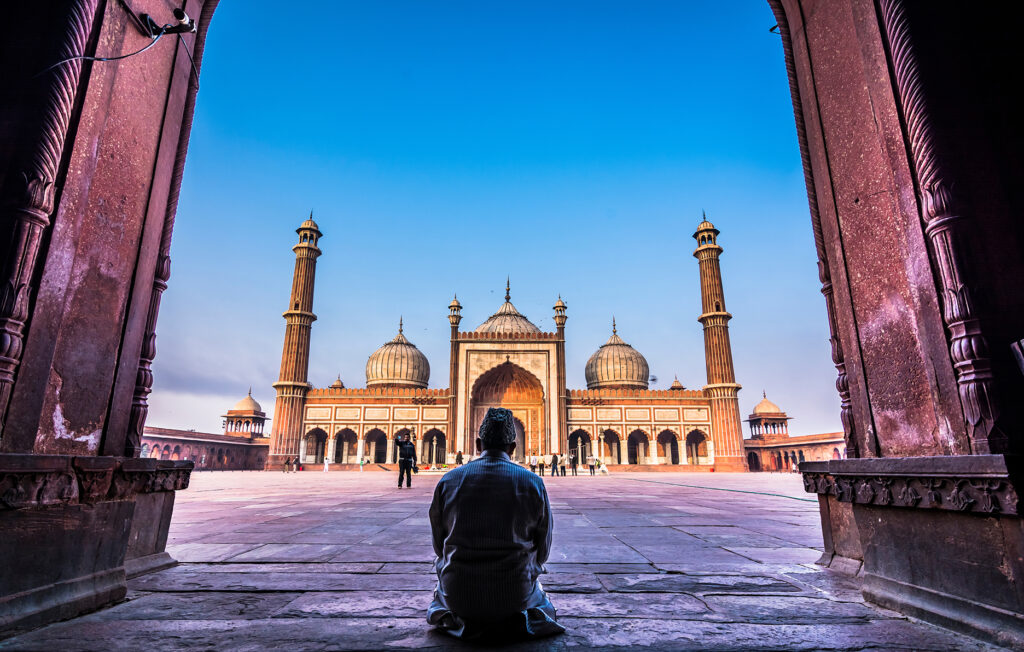By Amir Ullah Khan
July/August 2023

The situation must have been dire just after the partition of the South Asian subcontinent in 1947. A new country had taken birth and millions of people across both borders were displaced. In India, particularly in Punjab, Uttar Pradesh and Delhi, it was difficult being a Muslim. The atmosphere became grim again in 1965, during the India Pakistan war when Muslims were being asked to prove their loyalties. Are Indian Muslims in a similar situation today?
The ruling coalition is making calls for genocide. Ruling chief ministers of big states are gloating about closing madrasahs. Prominent leaders talk about banning Urdu and courts are upholding bans on wearing head scarves.
The outlook does appear bleak. But what makes it worse is that there is enough evidence of state complicity in all this persecution. Even in the worst of post-partition times, and during the wars with Pakistan, the state was clear on its neutral position. The constitution swore by secularism and the law makers were bound by the law of the land. Today, the government indulges in extrajudicial killings, demolishes mosques despite court orders, and state laws disallow Muslims from buying property legitimately.
There is even more despair when we see the reaction among Muslims. But for a small group of intrepid journalists, mostly women, there is a sense of dread. Most of the Muslim leadership has shrunk into a fetal position, particularly in North and Central India. Prominent Muslim intellectuals and former bureaucrats make feeble and desperate attempts at reaching out to the same organizations that support calls for genocide and argue for a second-class status for Muslims. Nowhere is this pusillanimity more obvious than when judges of the highest court pass controversial judgements, and soon after accept post-retirement positions that reek of a quid pro quo.
Justice Nazeer Ahmed’s case is an eye opener. As a Supreme Court judge, he retired in January this year, after signing off on the most bizarre Babri Masjid judgment. He led the Constitution bench that declared that demonetization was not illegal, even as his colleague Justice Navarathna had categorically ruled that the process was faulty. Demonetization was easily one of the most devastating policy decisions ever taken by Modi. The Prime Minister had announced, without notice or explanation, a sudden ban on some currency notes on Nov. 8, 2016. Within forty days of his retirement, he was appointed the governor of Andhra Pradesh, a position he accepted and occupies today.
The dilemma that Muslim political leadership faces now is indeed reflective of the situation. Ghulam Nabi Azad, a member of the Congress Party and a formidable opposition leader for nearly 50 years, speaks helplessly in favor of Modi. Azam Khan of the Samajwadi Party gets a three-year jail term and spends 27 months there before getting bailed out. Religious leaders have been jailed under charges that were as bizarre as that of Muslims spreading Covid in the country. Now there are no Muslims in Narendra Modi’s cabinet. The ruling party does not have a single Muslim member of Parliament. What is even more heartless, is that there isn’t any Muslim member of the BJP in any legislative assembly in any state.
On the economic front, discrimination against Muslims has been on the rise for the last few years. This moved from a subtle call for boycotts against Muslims businesses to a violent attack on Muslim shopkeepers and hawkers. Muslims continue to lag behind everyone in access to electricity. Nearly 30% of Muslims in the poorest states are living without electricity even today.
On unemployment, the government’s own data makes a blunt point. Comparing data from the 61st round of the National Sample Survey on employment-unemployment (2004-05) to the Periodic Labor Force Survey in 2018-19 and 2019-20 and the All-India Debt and Investment Survey by the federal government, it is evident that there is a clear increase in inequality and discrimination against Muslims when it comes to access to jobs, income, health and agricultural credit across the country.
The data shows that unequal incomes are not only due to poor access to education or work experience but predominantly because of discrimination. Discrimination is the primary reason behind the falling Muslim Labor Force Participation Rate (LFPR) in the country. According to the government’s own data, as per the Ministry of Statistics & Program Implementation, among all populations, it is the Muslims that have the lowest share of working people. The LFPR for Indian Muslims has been consistently decreasing from 42.7% in 2004-05 to 30% in 2021. This shows the withdrawal of Muslims from the workforce despite rapid national economic growth in the same period.
In 2019-20, 40% of all non-Muslim populations aged 15 years and more had regular salaried and self-employed jobs. In contrast, these numbers were only 30% for similarly aged Muslims. This number has fallen sharply since 2015, with another sharp decrease seen during Covid.
While Muslims face the most discrimination in today’s India, the numbers also show that the workforce is also unfair to Dalits and indigenous groups. The average income for all vulnerable and marginalized groups in cities in India and are in regular employment is₹15312 ($186). The upper castes doing the same work get paid ₹20346 ($247) a month, at least 25% more, according to government data. It is also important to note that this wage differential is among those who are in regular work, and they comprise just 10% of India’s workforce.
It is a moot point on what kind of wage differentials exist in the unorganized and the informal economy where a large proportion of the marginalized minorities work. Most Muslims self-employed. The average earning for those self-employed is ₹15878 ($192) for the upper castes and ₹10533 ($128) for Muslims, lower castes and tribal populations. According to a 2022 Oxfam discrimination report, unequal income among urban casual wage workers is because of 79% discrimination in 2019-20.
While there was a general increase in unemployment during COVID, what was alarming was that in rural areas, the sharpest increase of 17 percent in unemployment was for Muslims. While 15.6% of urban Muslims aged 15 and above had regular salaried jobs, 23.3% of non-Muslims had regular salaried jobs in 2019-20. The Oxfam report estimates that the lower employment for urban Muslims is largely due to discrimination (68%) in 2019-20. While discrimination has always existed, the levels were different. The discrimination faced by Muslims in 2014 was 59.3% and has been increasing over the years.
While much has been written about the rise in hate crimes, lynching and police atrocities, it is important to note the increase in this kind of economic discrimination. The distressing point is that the violence against Muslims now is increasingly normalized. It is either ignored by the state or even encouraged by prominent leaders who support communal forces. It is a rational step for a politician, as it fetches votes and helps majoritarian consolidation.
What then is the solution? Where does hope come from? India is a great country and is growing fast despite all its problems. The solution must emerge from this growth. As the economy becomes stronger, identity issues and ethnic strife automatically take a back seat as we saw during the first decade of the new millennium. There is a constant pushback, within the boundaries of geopolitical realities, from foreign governments and agencies that ensures that the state responds. Just like it did in the hate speech on Prophet Muhammad (salla Allahu ‘alayhi wa sallam) where Nupur Sharma, a BJP spokesperson, was suspended from the ruling party.
The recent Karnataka election also shows that maybe, at least in states with higher levels of human development and industrial activities, there is a growing ennui against religious polarization. The voter did categorically dismiss religious slogans and propaganda movies, aimed at stirring the communal pot. Most of the ruling party allies, the Akali Dal in Punjab and the Thackeray faction of Shiv Sena in Maharashtra, the Telugu Desam in Andhra Pradesh have distanced themselves and are in the opposition now.
Finally, there is the Supreme Court, which under a new and assertive chief, Sharad Arvind Bobde, has underlined the basic structure of the constitution and constantly reminds the government of its duties and obligations. Therein lies the biggest hope for the world’s largest constitutional democracy.
Amir Ullah Khan, Ph.D., is professor of economics at the Marri Channa Reddy Human Resource Development Institute of the Government of Telangana, Hyderabad, India.
Tell us what you thought by joining our Facebook community. You can also send comments and story pitches to horizons@isna.net. Islamic Horizons does not publish unsolicited material.
